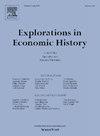The economics of Greco-Roman slavery
IF 1.7
1区 历史学
Q1 ECONOMICS
引用次数: 0
Abstract
This paper investigates the economic aspects of slavery in the ancient Greco-Roman world. Existing evidence reveals significant variation in the relative cost of slaves compared to unskilled wages: it appears that at different times and places, a typical slave could be purchased for prices equivalent to wages paid from 150 to 1000 days of unskilled labor. To explain this great disparity, we develop a principal–agent model that predicts the return on slaves relative to wages, which varies as a function of the prevalence of slavery in the labor force. This model implies that slavery may have increased aggregate labor productivity by reallocating workers from less productive to more productive regions within the Greco-Roman world.
希腊罗马奴隶制的经济学
本文研究了古希腊罗马世界奴隶制的经济方面。现有证据表明,与非熟练工人的工资相比,奴隶的相对成本存在显著差异:似乎在不同的时间和地点,一个典型的奴隶可以以相当于150至1000天非熟练工人工资的价格购买。为了解释这种巨大的差异,我们开发了一个委托代理模型来预测奴隶相对于工资的回报,该模型随劳动力中奴隶制的普遍程度而变化。该模型暗示,在希腊罗马世界,奴隶制可能通过将工人从生产率较低的地区重新分配到生产率较高的地区,从而提高了总劳动生产率。
本文章由计算机程序翻译,如有差异,请以英文原文为准。
求助全文
约1分钟内获得全文
求助全文
来源期刊

Explorations in Economic History
Multiple-
CiteScore
2.50
自引率
8.70%
发文量
27
期刊介绍:
Explorations in Economic History provides broad coverage of the application of economic analysis to historical episodes. The journal has a tradition of innovative applications of theory and quantitative techniques, and it explores all aspects of economic change, all historical periods, all geographical locations, and all political and social systems. The journal includes papers by economists, economic historians, demographers, geographers, and sociologists. Explorations in Economic History is the only journal where you will find "Essays in Exploration." This unique department alerts economic historians to the potential in a new area of research, surveying the recent literature and then identifying the most promising issues to pursue.
 求助内容:
求助内容: 应助结果提醒方式:
应助结果提醒方式:


